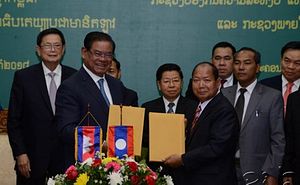Over the weekend, reports surfaced that Cambodia and Laos had reached agreement for both sides to withdraw troops from an undemarcated border area that had seen tensions over the past few weeks. The development highlighted the continuing discussion over what has prompted the new round of border tensions and how both sides will look to manage this in the coming weeks and months.
As I have observed before in these pages, Laos and Cambodia, two neighboring Southeast Asian states, share a 540-kilometer, partly demarcated land border, which has been a source of occasional disputes and differences between them over the years that has at times boiled over into conflict. Of particular note was a period of tensions in August 2017, when both leaders had to intervene to ensure de-escalation ensued.
Since then, while the military personnel and civilian leaderships of both sides have continued to hold exchanges and meetings to work through issues such as border surveys and remaining demarcation as well as address common security challenges such as cross-border crimes, misunderstandings and low-level tensions have still continued to simmer.
Over the past few weeks, these border tensions have been in the headlines again with reports of a border confrontation between Cambodian and Lao troops in the Mom Bei area in Preah Vihear province. Though details remain unclear, tensions date back to mid-August when Lao and Cambodian troops confronted each other along the area leading to concerns about escalation and even the potential evacuation of civilians.
But over the past few days, both sides have been keen to emphasize that the situation has been de-escalated. In comments to The Phnom Penh Post on Sunday, Cambodian Defense Minister Tea Banh dismissed the notion that there was a “confrontation” between the two sides, characterizing it as more of a “misunderstanding” on undemarcated areas. Lao troops had entered occupied Cambodian land along the Mom Bei area and removed crops planted by Cambodians. And Cambodian Prime Minister Hun Sen himself said in comments to Fresh News that after a Saturday morning conversation with Lao Prime Minister Thongloun Sisoulith, both sides had agreed to withdraw troops from the undemarcated area and would continue bilateral negotiations.
The path forward for both sides still remains unclear. As of now, Preah Vihear provincial governor Prak Sovann confirmed to Radio Free Asia on August 27 that both countries had agreed to withdraw troops following fears of escalation, even though Cambodian troops would redeploy not too far from the area. And the Lao military has said separately that following a meeting between senior military leaders, both sides would be withdrawing troops as of the morning of August 29 and would set up a joint committee to manage the border situation.
As with previous episodes of this ilk, one can expect both sides to continue on with efforts to smooth over these differences through a range of engagements. But while these moves may be welcome relative to potential escalation, the outbreak of continued tensions despite these efforts over the past few years also illustrates that these are at best temporary reprieves in border management as long as underlying issues remain unaddressed.

































